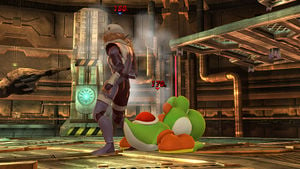Rage is a new mechanic in Super Smash Bros. 4, where a character's attacks will deal increased knockback as his or her damage rises. The effect is similar to Lucario's aura mechanic, though the damage dealt by attacks does not increase, and the increase in knockback is less significant. Rage begins to take effect past 35% damage, and maxes out at 150% damage. At maximum rage, attacks will deal 15% more knockback than normal. Rage is visually denoted by characters flashing red and smoke rising out of them when they reach 100%, and the effect grows more visually intense as damage rises farther until the aforementioned 150%; this visual effect making characters appear to be enraged is what led to the mechanic being named "rage" by the Smash community.
The obvious application of rage is that it allows players at higher damages to land KOs sooner than they would be able to otherwise, which can help aid a losing player staging a comeback, but it can also be used to assist a player with a stock lead in surviving for longer by keeping the opponent's finishing moves at bay. Rage is not necessarily a comeback-friendly mechanic, not just because of that, but also because the increased knockback can prevent combos from working sooner than they normally would, especially if the combo involves a setup from a high base knockback throw, making it more difficult for a highly-damaged player to rack up damage on a lower-damaged player. But on the other hand, rage can also assist in combos that rely on greater hitstun, such as stage-specific combos that rely on forcing opponents to close in on platforms to reduce defensive options and refresh the attacker's jumps.
Generally, heavyweight characters such as Bowser and Ganondorf benefit the most from rage, as their greater survivability allows them to both experience rage longer and to a greater degree, and the fact that heavyweights rely less on combos allows them to make greater use of the knockback increase, with little concern of it preventing vital combos. Characters that can rack up damage quickly without rage could lose that potential, however, as rage-induced knockback does not actually increase the amount of hitstun a character suffers.
Like stale-move negation, Rage is not present in single player modes such as Training mode (although the visual effects are still present). As such, its effects cannot be tested in that mode, requiring the player to do testing in Versus mode instead.
This mechanic was originally discovered by the Japanese community at the launch of Smash 3DS there and called the 'Hot Hot Effect'. Ayuha and Chibo then worked together to make a tutorial video on it and bring the information to the US scene, where Chibo then named it the 'Rage Effect'.
The Rage multiplier is 1 + [(p - 35)/115 * 0.15], where p is the damage percentage of the attacker (but no less than 35 and no greater than 150)[1]. Thus the minimum possible multiplier is 1 (no Rage effect) while the maximum possible multiplier is 1.15 (all knockback is increased by 15%). This multiplier is applied to the end of the knockback formula (as the variable r), alongside other conditional ratios such as the crouching penalty (x0.85), smash attack charge interruption bonus (x1.2), and grounded meteor smash penalty (x0.8). The first two multipliers are mutually exclusive to each other, as one cannot be crouching and charging a smash attack (even down smash) at the same time. This multiplier can also be directly applied to the base knockback and knockback scaling values of moves, resulting in the same effective knockback when calculated.
